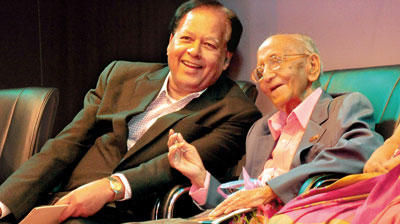Lester’s films the hallmark of a humanist
By Pic by Mangala Weerasekera“One of the few remaining cultural icons in our country who dominated Sinhala cinema for over 50 years and a giant of world cinema” is how Minister and art lover Dr. Sarath Amunugama delivering the Lester James Peries Oration 2012 last Tuesday, identified the doyen of Sri Lankan cinema.
“It is a privilege being able to pay a well deserved tribute to a close and affectionate friend for over half a century,” he remarked.
A mixed gathering at the Sri Sambuddatwa Jayanthi Mandiraya Auditorium listened to the Minister’s well structured speech that had several relevant quotes and interesting anecdotes.

A shared moment: Dr. Amunugama and Dr. Lester James Peries at the event last Tuesday.
He reminisced how he travelled to Balapitiya on Lester’s invitation to see a sequence of ‘Gamperaliya’ being shot at the Maha Kappina Walauwwa along with the author of the book, Martin Wickremasinghe and the screenplay writer Reggi Siriwardena in t he former’s car. Those were the days when film crews were on location for long periods and there was time for fellowship.
The scene they witnessed was the wedding of Piyal (Henry Jayasena) and Nanda (Punya Heendeniya) and everyone crowded in the verandah to get a glimpse of how it was being filmed. He recalled how Lester deployed his new players from stage – Tony Ranasinghe, G.W. Surendra and Wickrema Bogoda to give a sense of a festive occasion. There were also several foreigners to suggest that Piyal was now building his fortress in Colombo.
What impressed Minister Amunungama was Lester’s detachment, his whispers to the cameraman and the very gentle suggestions to the players which have become the hallmark of his direction.
Having seen all Lester’s films including the documentaries, he wanted to find the common thread binding his work – his personal vision, distinctive style and rhythm and his own cinematic language and idiom. “What stands out is his humanism,” Mr. Amunugama said and went on to discuss this aspect in depth.
Defining humanism as “any system, mode of thought and action with human interest, values and dignity predominates”, he said humanism that developed in western society after the Renaissance, had a strong influence on Lester. While he progressively delved into Sinhalese society, Lester was also a cosmopolitan intellectual, just as Satyajit Ray was. “Almost all the distinguished creative artistes and literary figures have all been largely influenced by their readings of the great works of western literature. Martin Wickremasinghe, Sarachchandra, Gunadasa Amarasekera and Siri Gunasinghe have all been influenced by classical western writers,” he pointed out.
“Martin Wickremasinghe was a voracious reader. He read the Russian classics by Tolstoy, Dostoevsky and Chekhov that spread his interest in humanism which grew out of his close observation first of events in south Sri Lanka and later, in the metropolis of Colombo which was being transformed by the beginnings of native capitalism. Lester, on the other hand was a product of the English-speaking Colombo upper middle class. His father was a well-to-do doctor. I was always intrigued by the appearance of a grave-looking doctor in Lester’s films like ‘Gamperaliya’, ‘Nidhanaya’ and ‘Madol Duwa’ usually giving a very rational and unhurried diagnosis which only confirmed what the audiences already knew as a difficult situation,” Mr. Amunugama said.
Lester was fascinated by English literature and culture of the post-war period which was part of the English avant garde.
Referring to Lester’s first feature film, ‘Rekawa’, Mr. Amunugama said that it marked the introduction of a new film language different from the prevailing South Indian idiom depicting the local, particularly Buddhist culture and society. The film also marked the first manifestation of Sinhala film in the regional and international critical arena.
He then went on to examine Lester’s cinema based on Martin Wickremasinghe’s trilogy – ‘Gamperaliya’, ‘Yuganthaya’ and ‘Kali Yugaya’ which showed the director’s humanist approach. These three need to be viewed as works of cinema not mere translations of Wickremasinghe’s works to celluloid. “Unfortunately the criticisms of the three films failed to understand that literature and cinema are two categorically different art forms. It was the same with Lester’s ‘Baddegama’,” he pointed out.
Touching on the subtle difference between the books and cinema, he pointed out how while the novel can delve into anthropological and psychological commentary (a frequent technique used by Martin Wickremasinghe) the film must perforce concentrate on events, action and characters. In the trilogy Lester has dropped the subsidiary characters and highlighted the key events.
Pointing out that it is Nanda who is brought to the fore in ‘Gamperaliya’ and ‘Kali Yugaya’ ( to him, the latter is “much better than ‘Yuganthaya’ “), he stressed that “by any standard, Punya Heendeniya is outstanding” in the two films. “She brings an emotional charge to a role that keeps the viewer transfixed.” As a director, Lester must be given full credit for focusing on this central character. The nuances of feeling of Nanda surrounded by people with simple emotions like Anula, Piyal and Simon Kabalana not only makes her to us a sympathetic character taking meanwhile us to a world of moral choices and sensitivity of feelings which help to get a better understanding view of human conditions, Minister Amunugama said.
The oration dealt with much more of the humanism in Lester’s films and it is sincerely hoped that the LJSP Foundation will release the full text sooner than later.
comments powered by Disqus


















